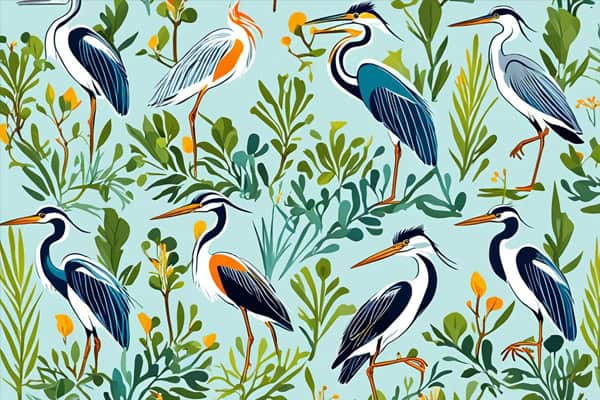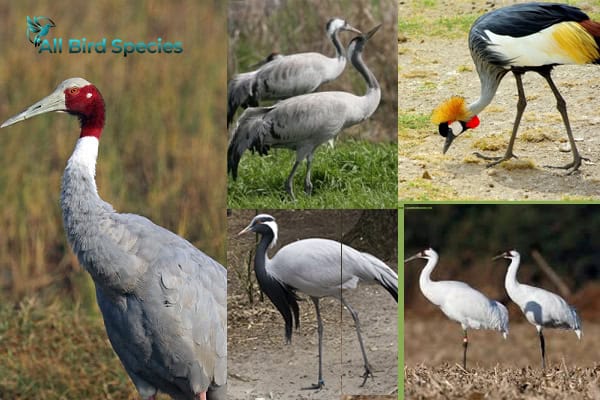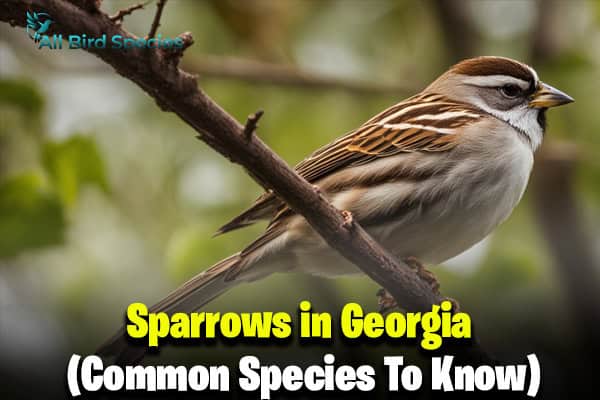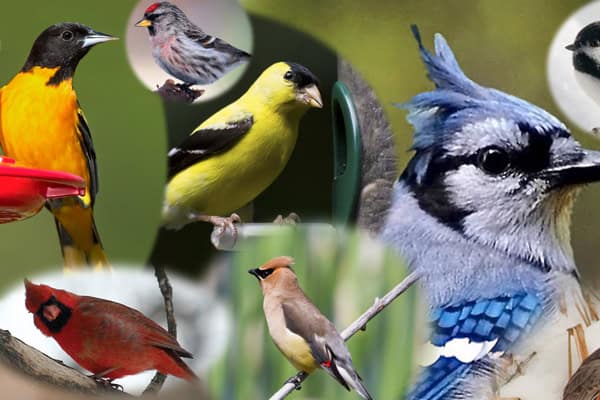12 Types of Herons Found in Florida (ID Guide)
Did you know Florida is home to over 12 different herons? These beautiful birds live in our wetlands and along our shores. They are important to their ecosystems. Let’s dive into the world of Florida herons, learn about their homes, and see how they live.
Whether you love birds or are just starting to get interested, learning about Florida’s herons will make nature more exciting. Let’s explore the amazing herons of Florida together.
1. Great Blue Heron
- Scientific name: Ardea herodias
- Life span: 15 years
- Size: 91-137 cm
- Weight: 2-3.6 kg
- Wingspan: 167-201 cm
The Great Blue Heron is a key bird in Florida’s wetlands. It catches our eye with its tall stature and elegant moves. Learning about its traits and how it eats helps us value its role in nature.

Identifying Characteristics
This bird is quite big, growing from 36 to 54 inches tall. It has a long neck and feathers that are grayish-blue. A black stripe above its eye makes it stand out. Seeing this heron in Florida’s wetlands lets us notice these unique traits.
Feeding Habits
Great Blue Herons eat fish, amphibians, and small mammals. They hunt by standing still in the water and then striking fast when prey is close. They build big nests in trees for breeding, often living in large groups with hundreds of others.
2. American Bittern
- Scientific name: Botaurus lentiginosus
- Life span: 6 years
- Size: 58-81 cm
- Weight: 0.4-1 kg
- Wingspan: 91-104 cm
The American Bittern is a bird that catches our eye with its unique traits. By learning about its features, we can better understand this hidden heron of our wetlands.
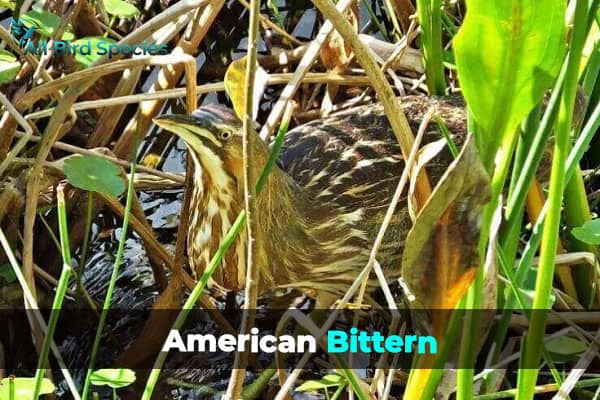
Identifying Characteristics
Identifying the American Bittern is easy with its distinct features. These herons are medium-sized, ranging from 23 to 32 inches tall. Their feathers are a mix of buffy brown with streaks, helping them blend into the marsh.
These birds love freshwater marshes and are quite secretive. Spotting them can be tough. But, their call during breeding season is a giveaway. Listen for the “oong-KA-chunk” sound to know they’re around, even if you can’t see them.
| Characteristic | Description |
|---|---|
| Size | 23-32 inches |
| Plumage | Buffy brown with streaks |
| Habitat | Freshwater marshes |
| Call | “Oong-KA-chunk” during breeding season |
3. Black-crowned Night-Heron
- Scientific name: Nyctanassa violacea
- Life span: 23 years
- Size: 58-66 cm
- Weight: 0.5-1 kg
- Wingspan: 91-112 cm
The Black-crowned Night Heron is a standout among herons. Its unique looks and ways make it interesting for bird lovers. Learning how to spot and understand this bird can deepen our love for nature.
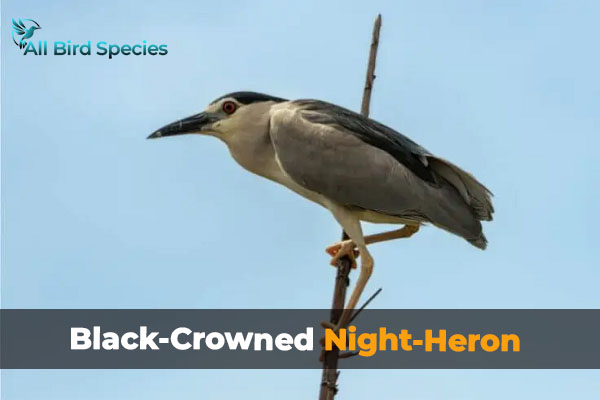
Identifying Characteristics
This heron catches the eye with its small size and hunched posture. Its black head and white belly stand out. It’s smaller than other herons, making it a special sight for birdwatchers. At twilight, it comes alive, adding to its charm.
Behavior and Habitat
The Black-crowned Night-Heron’s behavior is quite interesting. It’s most active at dusk and night. By day, it hides in thick vegetation to avoid predators and harsh weather. Its loud quacking call is a giveaway near its nests. These birds live in colonies, showing their social side and community spirit.
4. Green Heron
- Scientific name: Butorides virescens
- Life span: 7 years
- Size: 38-50 cm
- Weight: 0.1-0.2 kg
- Wingspan: 58-66 cm
The Green Heron is a fascinating small heron found in Florida. It lives near water, especially where plants are thick. It’s about 15 to 20 inches long. It has a greenish-black back and a chestnut-brown neck, making it stand out.
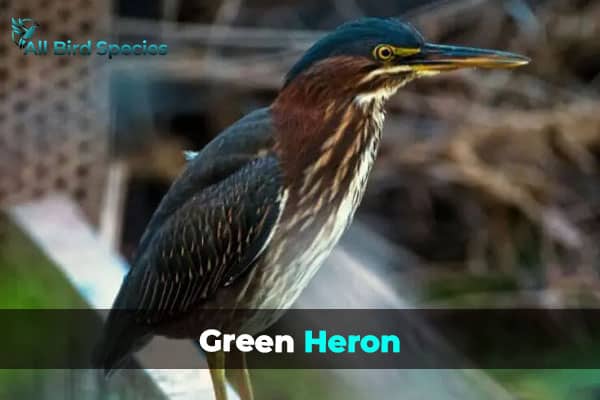
These birds are known for their smart hunting ways. They use tools to catch fish. They drop bait into the water to catch fish that come to eat it. This shows how smart and adaptable they are.
Green Herons hunt at twilight, during dawn and dusk. This helps them avoid big predators. Their sneaky moves and clever hunting make them interesting to watch for bird lovers and nature fans.
5. Great Egret
- Scientific name: Ardea alba
- Life span: 15 years
- Size: 81-101 cm
- Weight: 0.7-1.4 kg
- Wingspan: 140-170 cm
The Great Egret is a sight to behold, with its all-white look. It stands between 32-40 inches tall, having a long neck and a slender body. It also has a dagger-like yellow bill. During mating season, it becomes even more striking, making it easy to spot.

In the late 19th century, the Great Egret faced severe threats. Hunters wanted its beautiful feathers, putting the birds at risk of extinction. But thanks to conservation efforts, the Great Egret has made a strong comeback.
Today, we celebrate the Great Egret’s recovery as a success in wildlife preservation. We can now enjoy these beautiful birds in their natural habitats.
Related Video about Herons of Florida:
6. Cattle Egret
- Scientific name: Bubulcus ibis
- Life span: 9 years
- Size: 46-56 cm
- Weight: 0.2-0.5 kg
- Wingspan: 88-96 cm
The Cattle Egret is a unique bird that lives in fields, not wetlands like many others. They are often seen with livestock on farms, looking for insects. This lets us see how they use the animals to find food.
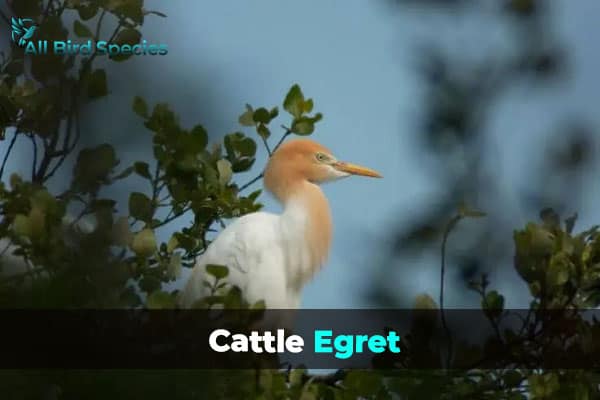
These birds are known for their white plumage, which changes with the seasons. In breeding season, they have yellow legs and sometimes decorations on their head and neck. Outside of breeding, they are all white. This makes them interesting to watch.
Cattle Egrets are fascinating to birdwatchers and wildlife lovers. Their looks and behaviors make them stand out. Learning about them helps us appreciate the variety of herons in different places.
| Characteristic | Breeding Adults | Non-Breeding Adults |
|---|---|---|
| Plumage Color | Mostly White with ornamental yellow | Completely White |
| Leg Color | Yellow | Yellow |
| Common Habitat | Agricultural Fields | Agricultural Fields |
| Feeding Behavior | Forages with livestock | Forages with livestock |
7. Snowy Egret
- Scientific name: Egretta thula
- Life span: 17 years
- Size: 56-66 cm
- Weight: 0.3-0.6 kg
- Wingspan: 86-102 cm
The Snowy Egret is a medium-sized heron known for its all-white look and black legs. These legs stand out against its bright yellow feet. We’ve seen how they stir up mud and water with their feet to find food. This shows how adaptable they are and helps them find hidden prey.
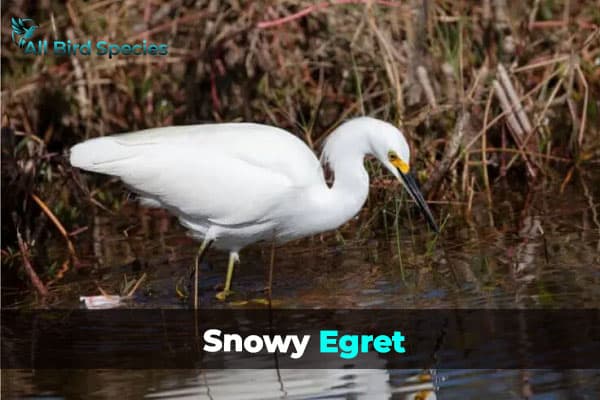
Spotting a Snowy Egret can be thrilling for bird lovers. They stand out with their size and looks. We’ve noticed that in their nests, there’s often a fight for food. Sometimes, the weakest chick gets pushed out, showing how tough survival can be.
8. Least Bittern
- Scientific name: Ixobrychus exilis
- Life span: 6 years
- Size: 28-36 cm (11-14 in)
- Weight: 0.1-0.2 kg (0.2-0.5 lbs)
- Wingspan: 41-51 cm (16-20 in)
The Least Bittern is a small heron found in Florida’s wetlands. It’s hard to spot because it likes to hide. But seeing it is a big reward. It has a special look with a hunched back and a long, sharp beak.
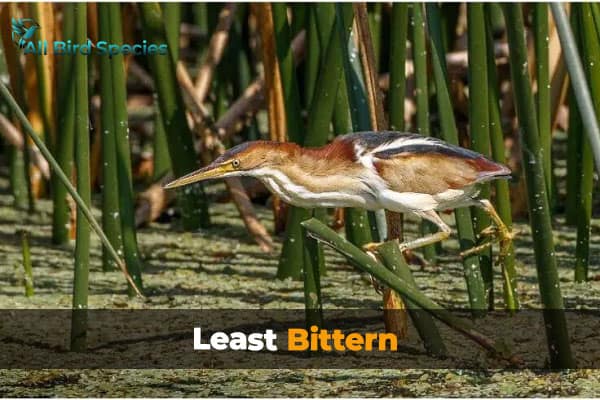
Male Least Bitterns have darker feathers than females. This makes it fun to figure out if you’re looking at a male or a female. They are great at hiding, which helps them stay safe from predators.
The Least Bittern makes a unique sound in the spring. This sound is a good clue to where they might be hiding. Watching these sounds can be a special experience for bird lovers.
| Characteristic | Description |
|---|---|
| Species Size | Smallest heron species in Florida |
| Coloration | Males: darker; Females: lighter |
| Habitat | Marshes and wetlands |
| Behavior | Secretive, relies on camouflage |
| Breeding Call | Distinctive and often heard in spring |
9. Yellow-crowned Night-Heron
- Scientific name: Nyctanassa violacea
- Life span: 23 years
- Size: 58-66 cm
- Weight: 0.5-1 kg
- Wingspan: 91-112 cm
The Yellow-crowned night heron is a bird that catches the eye of Florida’s heron species. It’s known for its unique look, making it a key part of our coastal ecosystems.

Identifying Characteristics
Here are some key traits to spot a yellow-crowned heron:
- Size: It’s about 23-26 inches long.
- Coloration: Its body is mostly gray, with bright yellow legs.
- Facial Markings: It has a black face, white cheeks, and a noticeable yellow crown.
These herons live in coastal areas and mangroves. They’re great hunters, especially at night, which helps them survive in different water environments.
| Characteristic | Description |
|---|---|
| Length | 23-26 inches |
| Leg Color | Yellow |
| Body Color | Gray |
| Face Color | Black with white cheeks |
| Crown Color | Yellow |
Learning about the Yellow-crowned night heron helps us appreciate these birds more. Whether we see them in the wild or learn about their habits, we connect with our environment and the amazing wildlife it supports.
Herons of Florida: Conservation Efforts
Our commitment to protecting herons in Florida is stronger than ever. These beautiful birds need wetlands to live. That’s why saving their homes is crucial. Groups are working hard to fix important habitats for herons.
Teaching people about herons is key. By sharing how important they are, we build a community that cares. This helps people join in on saving these birds.
| Conservation Initiative | Description |
|---|---|
| Wetland Restoration | Efforts aimed at restoring natural wetlands to support diverse wildlife, including herons. |
| Public Education | Programs designed to teach about the importance of herons and their habitats. |
| Legal Protections | Regulations that safeguard heron habitats from development and pollution. |
We want to make sure future generations can still see the herons in Florida. By working together, we can help keep our ecosystem healthy.
Check Our Previous Articles:
| Hawks in Virginia |
| Hawks in Pennsylvania |
| Birds of the African Savanna |
| Hawks in North Carolina |
| Are Black Peacock Real or Fake? |
Wrapping Up…
In this overview of Florida herons, we’ve looked at the different species that live in our wetlands. Each one adds to the rich life of the ecosystem. We’ve seen how they stand out with their unique looks and actions. They play a key role in keeping the environment healthy.
Florida’s diverse places show us the beauty and complexity of bird watching. These birds let us see nature up close. We can watch their graceful flight and how they hunt with skill. By learning and caring, we help protect their homes and encourage others to love our wildlife.

